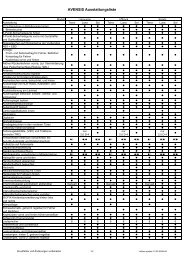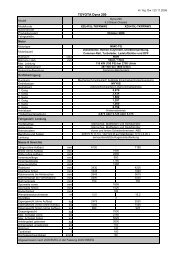tal leadership by maintaining the performance of more than ... - Toyota
tal leadership by maintaining the performance of more than ... - Toyota
tal leadership by maintaining the performance of more than ... - Toyota
Create successful ePaper yourself
Turn your PDF publications into a flip-book with our unique Google optimized e-Paper software.
Engaging with Employees<br />
Takashi Karasawa<br />
Vice-President Human Resources<br />
& Business Services<br />
Stable Employment<br />
We have made every effort to maintain stable employment<br />
for our permanent employees. The step-<strong>by</strong>-step approach<br />
that we introduced in FY08 to minimise <strong>the</strong> impact <strong>of</strong><br />
required cost reductions continued in FY10, in addition to<br />
some <strong>of</strong> <strong>the</strong> structural changes, such as limited recruitment<br />
and minimising overtime:<br />
We continued a limited ratio <strong>of</strong> “work-sharing” in <strong>Toyota</strong><br />
Motor Manufacturing Turkey (TMMT), where labour cost was<br />
reduced with a commensurate reduction in working time<br />
In <strong>Toyota</strong> Motor Manufacturing UK (TMUK), we needed to align<br />
our production capacity to demand, and <strong>the</strong>refore stopped<br />
one production line. To adjust <strong>the</strong> headcount, TMUK initiated<br />
its second voluntary separation scheme, where approximately<br />
850 members chose to leave. This necessitated a massive<br />
multi-skill training initiative to allow every team member who<br />
opted to stay to gain <strong>the</strong> skills to work on <strong>the</strong> operational line<br />
In <strong>Toyota</strong> Motor Europe a voluntary resignation programme<br />
was also introduced and approximately 200 members opted<br />
to fi nd external opportunities.<br />
To a limited extent, some <strong>of</strong> our NMSCs also optimised <strong>the</strong>ir<br />
organisations, while ensuring thorough communication with<br />
<strong>the</strong>ir members.<br />
Employee Communication<br />
In all <strong>the</strong> European countries in which we operate, we adhere<br />
to European and national legislation. In line with this, employee<br />
representation bodies are in place to inform and communicate<br />
within <strong>the</strong> framework <strong>of</strong> social dialogue based on mutual trust,<br />
Despite <strong>the</strong> fact that we are in our third year <strong>of</strong><br />
this crisis, we take pride in <strong>the</strong> fact that we have<br />
made every effort to maintain our ideology and<br />
values on how we treat our employees. While<br />
we were again forced to reduce some <strong>of</strong> our<br />
headcount, we continued to work hard to try and<br />
achieve this through voluntary means, supported<br />
<strong>by</strong> effective communication.<br />
respect and responsibilities. Regular information sharing and<br />
required consultations with European and national bodies<br />
contributed to <strong>maintaining</strong> <strong>the</strong> relationship and ensured<br />
understanding <strong>by</strong> employee representatives on <strong>the</strong> business<br />
situation and company’s position.<br />
In line with <strong>the</strong> agreement with our European Works Council,<br />
which is called <strong>the</strong> <strong>Toyota</strong> European Forum (TEF), additional<br />
meetings were convened to discuss <strong>the</strong> various business<br />
issues in our European operations.<br />
Under <strong>the</strong> continuing severe business and economic<br />
conditions, it was critical to communicate with all our<br />
employees in an open and timely manner. On several<br />
occasions face-to-face meetings were organised between<br />
<strong>the</strong> company management and employees to explain critical<br />
business issues and company decisions. Pan-European<br />
employee briefi ngs were held throughout <strong>the</strong> year to ensure<br />
consistent and thorough communication with all European<br />
employees.<br />
Employee Motivation Survey<br />
Takashi Karasawa<br />
One <strong>of</strong> <strong>the</strong> ways we monitor and measure employee<br />
engagement is through our employee motivation survey. The<br />
survey is conducted every two years and includes all our<br />
European affi liates. While NMSC employee engagement was<br />
relatively high and in line with high performing benchmarks,<br />
this was not achieved in <strong>the</strong> manufacturing plants and <strong>the</strong><br />
head <strong>of</strong>fi ce, where a dip was seen against <strong>the</strong> 2008 results.<br />
The results were communicated to employees and in line<br />
with local practice and requirements, working groups or<br />
management workshops were established to develop action<br />
plans to address <strong>the</strong> identifi ed issues. As a result <strong>of</strong> <strong>the</strong><br />
motivation survey, numerous changes have been introduced<br />
in <strong>the</strong> areas <strong>of</strong> communication, training and HR systems.<br />
<strong>Toyota</strong> European Sustainability Report 2011 I Social Performance<br />
47

















